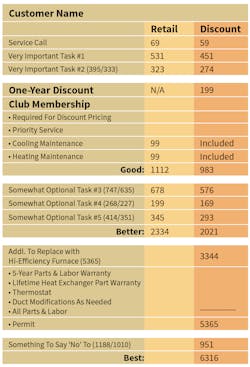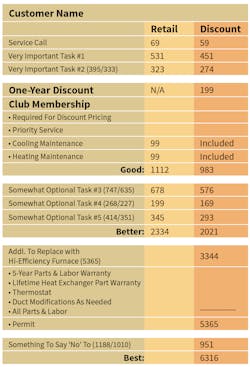The HVAC 'Repair vs. Replace' Scenario
Charlie Greer is providing a year-long series describing his procedure when running service or sales calls. His other articles in this series are listed at the bottom of this article.
I always act as though I’m prepared and willing to repair their old equipment, so I always write up the repair quote, no matter how foolish, in my opinion, it would be to repair it.
Refusing to write up the repair quote could cost you a customer. When your customers really want a repair quote, and you refuse to give them one, they have no other choice but to pay your minimum charge and call another contractor so they can make an informed decision based on hard numbers.
Whatever decision the customer makes, support it. Don’t make them feel bad or stupid when they opt to repair equipment you feel should have been replaced.
In the long run, you make more money when they opt for the repair anyway. You get one repair now, possibly a few more down the road, then a higher price (due to inflation) when they ultimately replace it in the future.
The ‘Paper Towel Close’ Format
When quoting repair vs. replace:
1. Write up the repairs the same way you normally would
2. Subtract the dollar amount of the repairs from the dollar amount of the replacement
3. Below the total amount of the repairs, write “Additional to replace” and put the difference between the replacement cost and the repair cost in the “Discount” column
4. Make a subtotal
5. Add the IAQ products and/or an option to replace the complete system or upgrade to higher priced equipment
6. Do a final total.
In the example shown, the cost to bring their existing furnace up to manufacturer’s specs is $2,021, under the terms of a service agreement. The price for a new furnace is $5,365, installed.
For only another $3,344, it can be replaced with a high-efficiency model with a warranty.
It makes the $5,365 for a new furnace easier to swallow. I’ve had customers thank me for writing it up this way.
Note that there is no price to replace the equipment under the “retail” column. That’s because everyone who invests in replacement equipment gets a one-year service agreement, which automatically makes them a customer who is entitled to discounts. I suggest pricing your equipment such that the service agreement price is the price you want, and just make that the price everyone is quoted.
The PTC Does the Talking For You
When you write it up this way, you might not even have to “sell” the concept of replacing the equipment. In fact, you might not have to bring it up at all.
Once I was told the way to a call not to bring up the idea of replacing this customer’s furnace. I was told, “He’s a long-term customer. He knows he needs a new furnace, and he said that if anyone ever says anything about a new furnace again, he’s going to throw us out of the house.”
His furnace was in bad shape and needed a lot of work if he wanted it to last. I wrote up the PTC using my “Repair vs. Replace” format, and went over my findings with him, saying nothing about replacing his furnace. When I showed him the PTC, I still said nothing about a new furnace, but he could plainly see it near the bottom of the paper.
“What’s this?” he asked. “How much it would be for a new furnace?”
“Yes,” I responded.
“Well, it would be foolish for me to put this much money into an old furnace when I could get a new one.”
“So, you want the new furnace?” I asked.
He did. I’ve closed on a lot of equipment sales without hardly saying a word.

